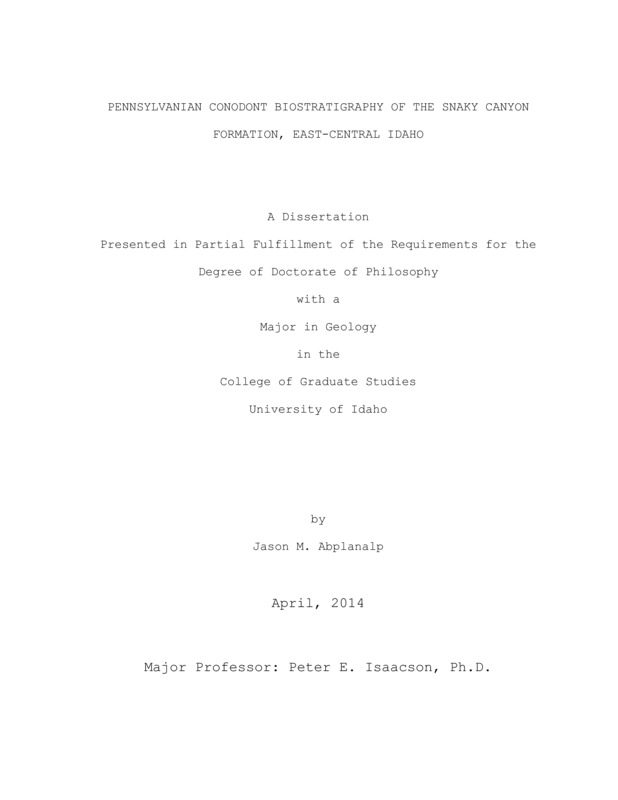Pennsylvanian Conodont Biostratigraphy of the Snaky Canyon Formation, East-Central Idaho
Abplanalp, Jason. (2014). Pennsylvanian Conodont Biostratigraphy of the Snaky Canyon Formation, East-Central Idaho. Theses and Dissertations Collection, University of Idaho Library Digital Collections. https://www.lib.uidaho.edu/digital/etd/items/abplanalp_idaho_0089e_10182.html
- Title:
- Pennsylvanian Conodont Biostratigraphy of the Snaky Canyon Formation, East-Central Idaho
- Author:
- Abplanalp, Jason
- Date:
- 2014
- Keywords:
- Biostratigraphy Carboniferous Conodonts Pennsylvanian Stratigraphy
- Program:
- Geology
- Subject Category:
- Geology; Paleontology
- Abstract:
-
Abstract
Early (Morrowan) to Late (Missourian) Pennsylvanian conodonts from the Snaky Canyon Formation in east-central Idaho establish biostratigraphic dating of more-or-less continuously deposited foreland basin sequences. Within a siliciclastically influenced carbonate dominated succession, fifteen consecutive conodont biozones are defined and traceable along a 90 km. east to west transect in Idaho's Basin and Range Province. These biozones were deposited along a eustatically and tectonically influenced continental platform recording deep subtidal to nearshore, peritidal eolian, siliciclastic influenced deposition. Conodont faunas within the biostratigraphic interval are dominated by species of Adetognathus, Rhachistognathus, Declinognathodus, Idiognathodus, Idiognathoides, Neognathodus, and Streptognathodus which comprise over 95% of all conodonts recovered. The fifteen Morrowan to Missourian conodont biozones are the 1) Rhachistognathus primus biozone - lowermost Morrowan, 2) Declinognathodus noduliferous biozone - lower Morrowan, 3) Idiognathoides sinuatus biozone - middle Morrowan, 4) Idiognathodus sinuosus biozone - middle to upper Morrowan, 5) Steptognathodus suberectus biozone - upper Morrowan, 6) Declinognathodus marginodosus/Idiognathoides sulcatus parvus biozone - lower Atokan, 7) Neognathodus atokaensis biozone - lower Atokan, 8) Idiognathodus incurvus biozone - middle Atokan, 9) Neognathodus bothrops (columbiensis) biozone - upper Atokan to lowermost Desmoinesian, 10) Neognathodus asymmetricus biozone - lower Desmoinesian, 11) Idiognathodus obliquus biozone - lower to middle Desmoinesian, 12) Idiognathodus expansus biozone - upper Desmoinesian, 13) Idiognathodus magnificus biozone - uppermost Desmoinesian to lowermost Missourian, 14) Idiognathodus sp. "X" biozone - lower Missourian, and 15) Swadelina nodocarinata biozone - lower Missourian.
These defined biozones redefine stratigraphic positioning of rock units and provide a framework for correlation. The Bloom Member of the Snaky Canyon Formation was deposited from the basal Morrowan to the earliest Missourian and the Gallagher Peak Sandstone Member was time transgressive from west (Desmoinesian) to east (Missourian). Conodonts from the lower Juniper Gulch Member at the type locality indicate a Morrowan to Atokan age, making the member correlative with the Bloom Member. Palaeoaplysina buildups initially occur in the middle Desmoinesian. Tectonic and eustatic controls greatly influenced deposition during the early Atokan (eustatic), late Atokan (tectonic), and middle Desmoinesian (mixed). Cyclicity is of 4th order (parasequence) scale that comprises at least three 3rd order sequences.
- Description:
- doctoral, Ph.D., Geology -- University of Idaho - College of Graduate Studies, 2014
- Major Professor:
- Isaacson, Peter E
- Committee:
- Rember, William C; Williams, Thomas J; Grader, George C
- Defense Date:
- 2014
- Identifier:
- Abplanalp_idaho_0089E_10182
- Type:
- Text
- Format Original:
- Format:
- application/pdf
- Rights:
- In Copyright - Educational Use Permitted. For more information, please contact University of Idaho Library Special Collections and Archives Department at libspec@uidaho.edu.
- Standardized Rights:
- http://rightsstatements.org/vocab/InC-EDU/1.0/

